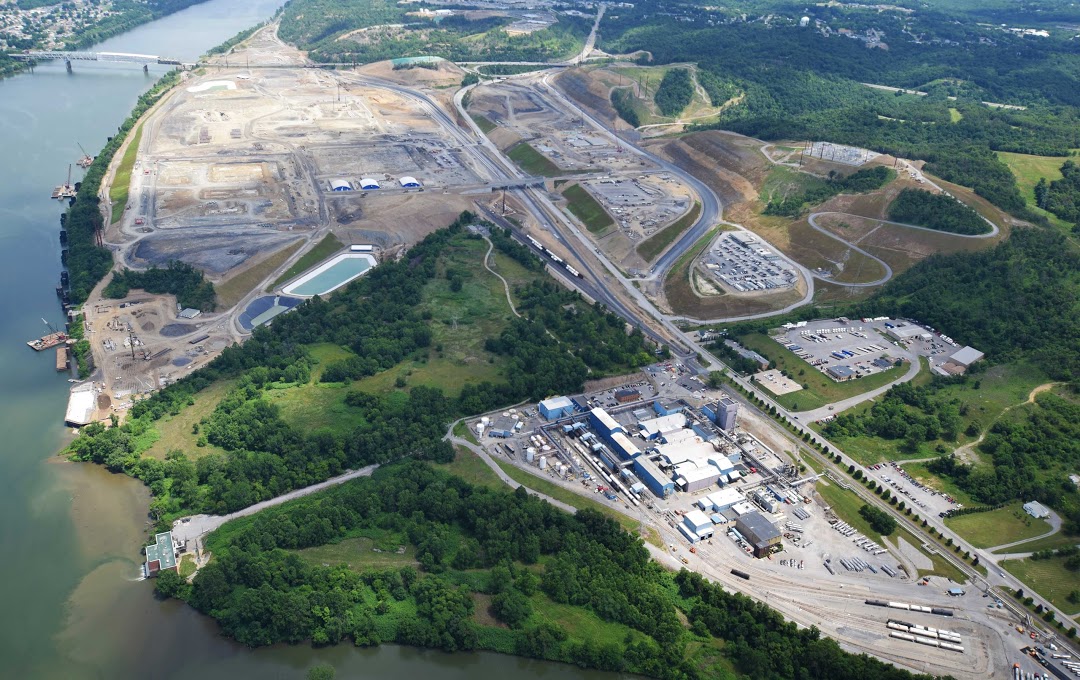At the end of 2017, Shell ran slightly afoul of Pennsylvania state regulators after filing a pipeline permit application to the state and the U.S. Army Corps of Engineers that failed to show sensitive environmental areas in the path of its proposed Falcon ethane pipeline. Now, a concerned nonprofit has pieced together the details Shell should have included (and more), revealing hundreds of homes, schools, streams, and wetlands in the path of the fracking products pipeline.
The 97-mile Falcon Ethane project will carry more than 107,000 barrels a day of a flammable plastics precursor to a small town in Pennsylvania where Shell is building an ethane “cracker” facility. In a region poised to be transformed by petrochemical development, this huge plastics plant will superheat the ethane and “crack” it as it manufactures over a million tons per year of tiny plastic beads of ethylene or polyethylene.
Shell’s pipeline plan lacked maps that would show area creeks, rivers, waterways, and other sensitive areas like wildlife sanctuaries and preserved lands, the state Department of Environmental Protection said after it issued “incompleteness letters” to the plant in October, a local newspaper, The Times Online, reported.
Areas at Risk From Falcon Pipeline
Now, in a rare detailed look at this early stage of pipeline planning, the FracTracker Alliance, a nonprofit focused on “the risks of oil and gas development,” has published a Falcon Public Environmental Impact Assessment Project, detailing the impacts and risks the Falcon pipeline will bring to Pennsylvania, West Virginia, and Ohio.
“Companies are generally not required to publicly disclose GIS data when applying for permits,” said Kirk Jalbert, project lead and Manager of Community Based Research and Engagement at FracTracker, but the group found a cache of detailed geographic information system (GIS) data in December 2016. “While concerned citizens can stitch together paper maps provided by companies in their applications, that process can be complex and very labor intensive.”
FracTracker’s analysis found that, assuming the project is built as planned, the Falcon pipeline will cross 319 streams and 174 wetlands and that “550 family residences, 20 businesses, 240 groundwater wells, 12 public parks, 5 schools, 6 daycare centers, and 16 emergency response centers are within potential risk areas.”
Those risks include both explosions and vapor leaks. “Should a leak occur, ethane is not easily detected because it is a colorless and odorless gas,” FracTracker Alliance’s new site reports. “Slightly heavier than air and extremely flammable, triggers such as ignition of a car engine, cell phones, doorbells, or light switches can provide an effective ignition source if concentrations are high enough.”
A screenshot of one of FracTracker’s interactive maps, showing the path of the Falcon pipeline relative to what are known as “high consequence areas,” such as “population centers, drinking water systems, and sensitive habitats.” Credit: FracTracker.org
Another ethane pipeline, the 306-mile Mariner East 2 project, which will carry ethane and other natural gas liquids produced largely via hydraulic fracturing (or fracking) from Pennsylvania and Ohio to an Atlantic coast export terminal, has also drawn concern due to the risks associated with explosions. The pipeline’s path has prompted at least one local school to start conducting pipeline blast drills.
That project is currently suspended after state regulators found that its builder, Sunoco Pipeline, had committed “egregious and willful” violations of state law during construction.
The FracTracker data on Falcon is particularly noteworthy because the Federal Energy Regulatory Commission, or FERC, is expected to play a limited role in Falcon construction oversight, and according to FracTracker, that means Falcon will “not be subject to a full environmental impact assessment.” Instead, construction permitting will largely be conducted by state agencies, except where the pipeline crosses the Ohio River, which will draw scrutiny from the U.S. Army Corps of Engineers.
Construction will nonetheless bring serious impacts, FracTracker’s new analysis reveals. Over half of the planned route runs through areas that are currently forested or farmland, the group found. When it comes to wildlife, FracTracker’s analysis showed that habitat for rare or endangered animal species — including bald eagles, short ear owls, northern long-eared bats, the amphibious eastern hellbenders, and freshwater mussels — falls in or near the pipeline’s proposed route. The project also will pass by an old coal mine and coal slurry site, as well as nearly 50 natural gas wellheads, homes for nearly 2,500 people, and eight drinking water protection areas.
Local landowners may find the “easements” section the most fascinating data, as the group shows parcels of land that have already been leased by Shell and areas where the proposed route runs through as-yet unleased land. The company has made area headlines as it seeks to buy up the land along the route.
Those negotiations are unusually sensitive, as company officials have said they don’t plan to use eminent domain to take property because its ethane pipeline will feed a private petrochemical plant. That’s arguably in a different class than natural gas pipelines, which are considered public utility projects and allowed to simply seize private land rights when negotiations with landowners fail.
Construction is slated to start this fall, and Shell expects Falcon to go into service in 2020.
Turning Pennsylvania into a Second ‘Cancer Alley’?
In part, what makes this project unique are the detailed graphics, interactive maps, and other context about the surrounding neighborhoods, ecosystems, and infrastructure, which make understanding the Falcon pipeline’s full impacts much easier.
“The Falcon Public EIA Project is meant to expand public dialogue about what should be included in EIAs and how they should apply to petrochemical pipelines,” FracTracker said in a statement. “The project also serves as a model for how regulatory agencies can be more transparent with data when engaging the public.”
Shell Pipeline Co. has previously drawn fire for providing too little information about Falcon to the public. This summer, a petition calling for more transparency from Shell gathered over 4,000 signatures from locals concerned about Falcon’s impact on an area water reservoir.
“We need jobs here so badly,” Marcia Lehman, 67, of Harmony, Pennsylvania, told the Pittsburgh Post-Gazette this summer after an area water authority meeting about the Falcon pipeline, “but I’m against any type of job that makes people sick and would make us Cancer Alley.”
Disputes over Falcon may set the tone for years to come, as Falcon could be followed by many more ethane projects in western Pennsylvania and the Marcellus Shale region, a hotbed for natural gas production. The industry is eyeing the region as a second petrochemical alley, similar in scope to the plastics corridor along the Gulf Coast. [Check out Julie Dermansky’s ongoing coverage of Cancer Alley communities pushing back against the petrochemical pollution associated with this dense industrial region along the Gulf of Mexico.]
“While the region with its ample and reliable supply of ethane is primed for the emergence as a second major petrochemical manufacturing hub in the United States,” the “U.S. Northeast Petrochemical Industry Market Outlook 2018,” a white paper from Petrochemical Update, concluded, “it faces the challenges of rapidly developing a workforce, as well as storage and pipeline infrastructure to fuel such development.”
While Pennsylvania’s first new ethane cracker, Shell’s Beaver County plant, is already spurring a build-out of pipelines and infrastructure, Pennsylvania could find itself facing up to five times the impact in coming years, according to a 2017 report from oil and gas industry consultant IHS Markit, prepared for Pennsylvania Governor Tom Wolf’s office.
“Pennsylvania currently has a sufficient supply of NGL [Natural Gas Liquids] to support a world-class petrochemical industry,” IHS reported. “Its major competitive advantage is access to an expanding supply of low-cost natural gas and NGL (particularly ethane and propane) capable of supplying up to four additional world-scale, integrated ethane crackers similar in size to Shell Pennsylvania Chemicals.”
This possibility has drawn an alarmed response from many, including an umbrella group representing 140 local Presbyterian churches, concerned that a new petrochemical corridor will also bring pollution and illness.
“We are part of a faith tradition that has affirmed our responsibility to care for the earth as our home and care for all people, especially our most vulnerable populations,” officials from the Pittsburgh Presbytery wrote in December.
“We can’t ignore environmental issues any longer,” Rev. John Creasy, associate pastor of the Open Door Church in Highland Park told the Pittsburgh Post-Gazette, “especially in our region, where air quality is one of the worst in the nation and we have a fossil-fuel industry looking to take advantage of the poverty of our area and the need for jobs.”
The public can submit comments on the Falcon pipeline proposal to the Pennsylvania Department of Environmental Protection until February 20, 2018. More information is available on the FracTracker website.
Main image: “Future site of Shell Chemical Appalachia’s ethane cracker where the former Horsehead zinc smelter in Beaver County is housed.” Credit: Ted Auch, FracTracker Alliance, June 2016
Subscribe to our newsletter
Stay up to date with DeSmog news and alerts







